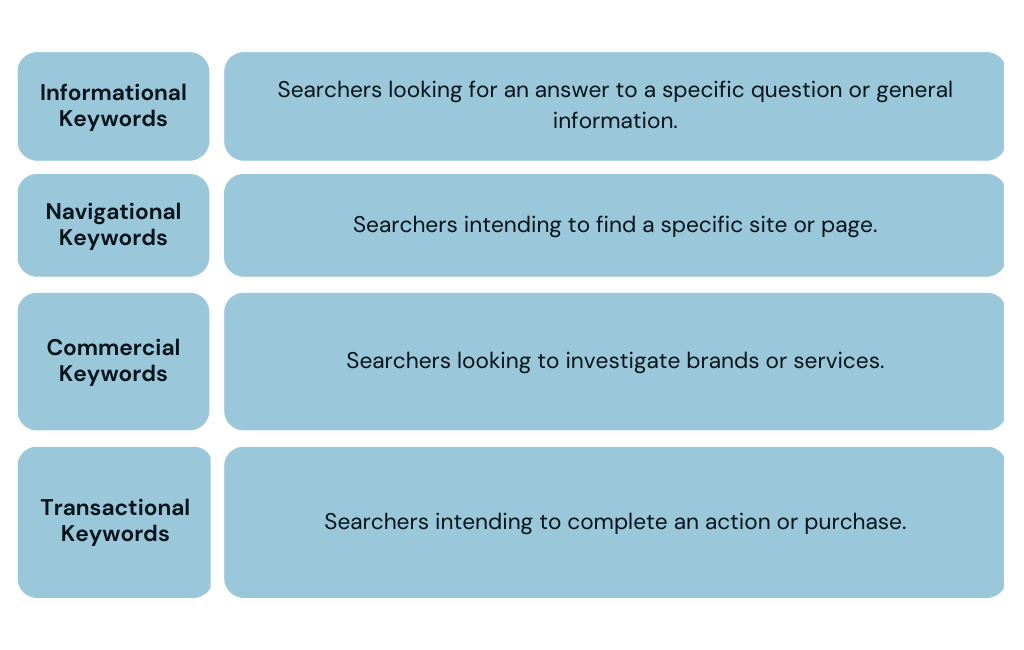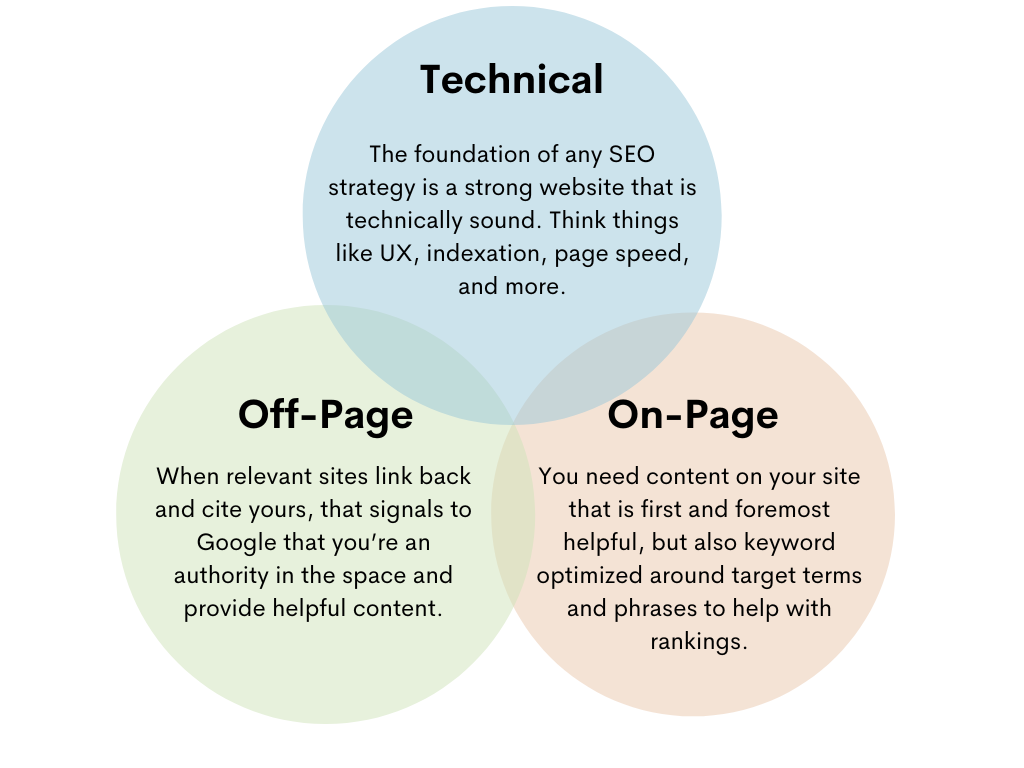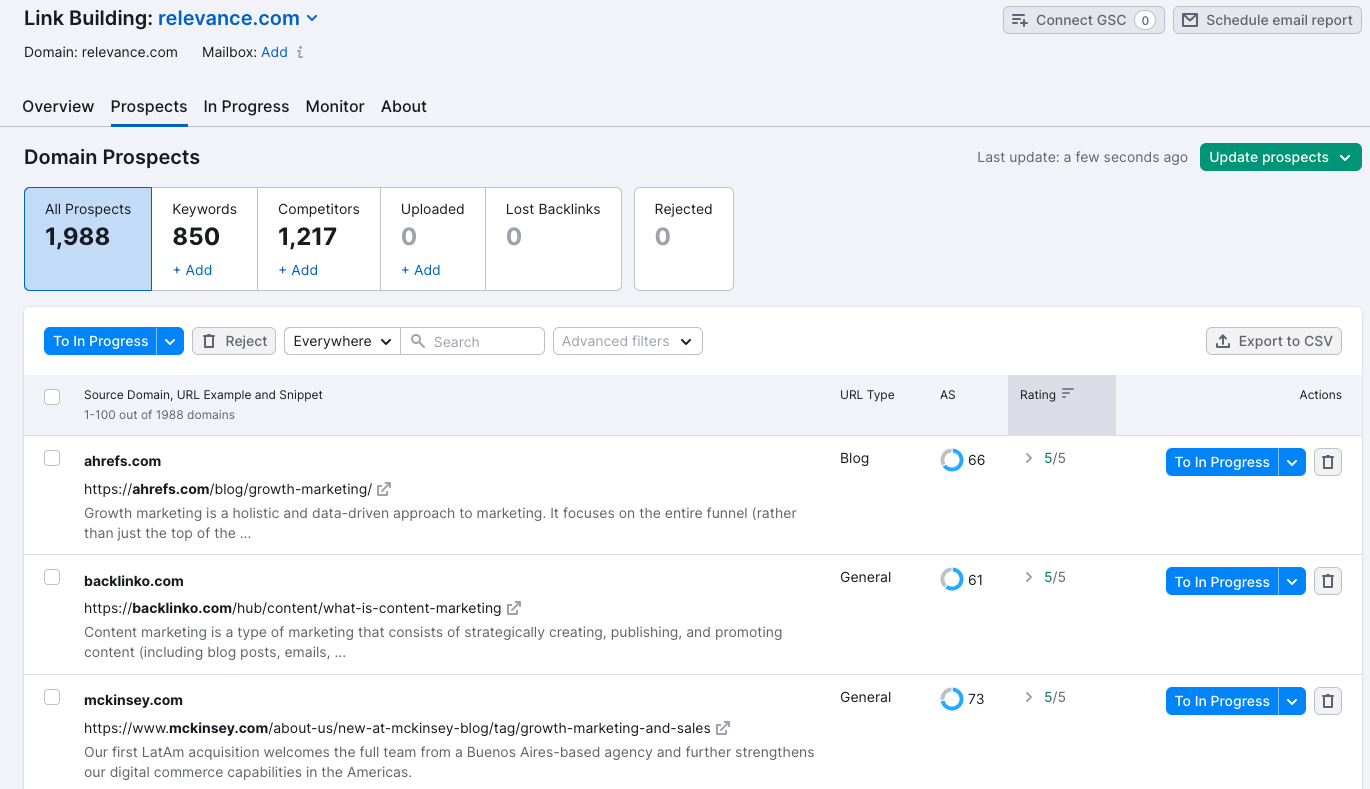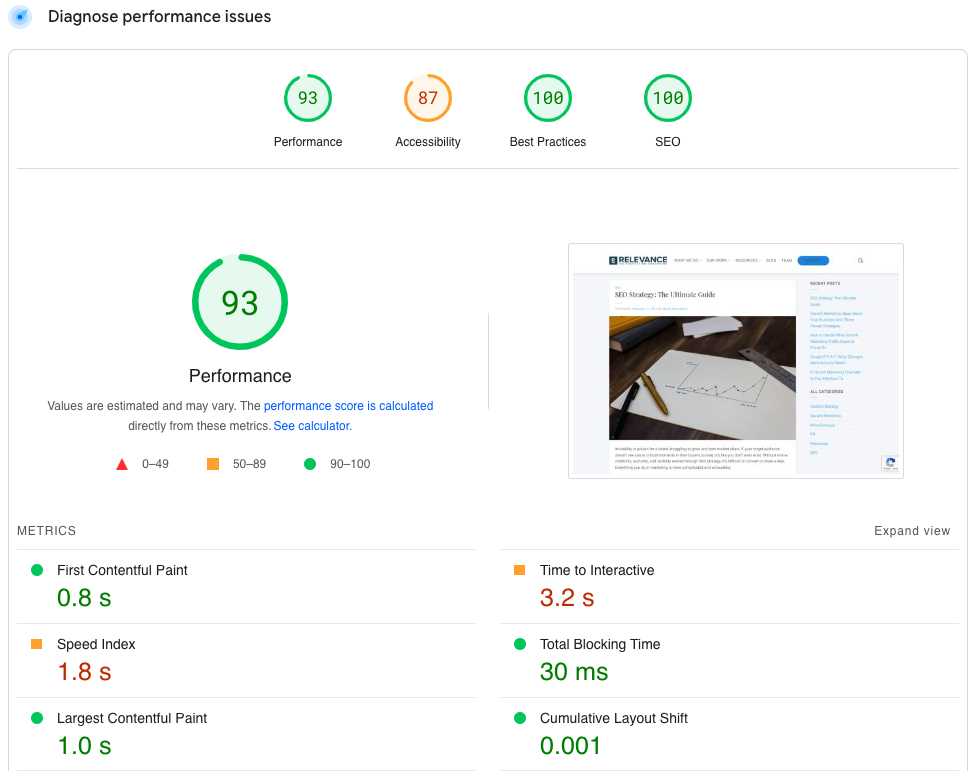Take a look at any “SEO checklist” and you’ll find hundreds of factors you could include in an SEO strategy. It can be hard to know where to start. As you’re evaluating search engine optimization techniques, here are the five most important factors to consider.
What are the 5 SEO factors?
Here are the main factors to think about as you’re building your plan of attack.
1. Strong technical foundation
The best integrated SEO plans are built on a solid technical foundation. Content-focused marketers might be tempted to ignore technical SEO (or at least save it for last). But it’s the cornerstone of high-ranking content.
That’s because search engines have gotten very good at identifying a great user experience. If Google sends a user to a poorly-designed website, the user is less likely to trust Google to provide the best search results. Therefore, if your website has technical issues or inefficiencies, your content won’t rank well, no matter how expertly-crafted it is.
For these reasons, it’s crucial to check table-stakes technical SEO elements like website speed, site structure, mobile-friendliness, and accessibility.
2. Keyword-optimized content matched to search intent
We talk a lot about keyword optimization in SEO. Why are keyword research and optimization so important?
Keyword research is valuable because it’s a kind of prospect research. As marketers, we’re sometimes removed from the audience we’re targeting. Unlike sales or customer service, we don’t interact with our prospects and customers every day. This distance can cause us to drift from research and start relying on assumptions.
Consistently including a keyword research step in your SEO strategy helps you validate your assumptions. It allows you to ask, “What topic is our audience actually searching for? What kind of language do they use when searching?”
A key part of keyword search is identifying search intent. Look at the types of keywords your audience uses. Are they informational, navigational, commercial, or transactional? Then, craft your content using this research.

3. On-site interlinking
When it comes to linking strategy in SEO, we sometimes jump straight to backlinks. But on-site interlinking also plays an important role in ranking.
Building links between your own website content helps search engines understand the structure and hierarchy of your website. From Google’s perspective, on-site interlinking passes link equity back and forth between your pieces of content.
Interlinking also improves your website’s user experience by making it easier to navigate. Think about it this way: New content you create is probably related to other content you’ve already published. Maybe the two topics are laterally connected, or maybe one piece is a deep dive into a concept mentioned in the other.
Users who landed on one piece from a Google search may not know about the other piece. It’s important to connect the two via on-site interlinking.
4. Backlinking
Of course, you can spend all day linking to your own content internally. But there’s a reason why 82% of consumers trust reviews and only 4% trust ads. What other people say about you is simply more credible than what you say about yourself.
That’s why building backlinks is one of the most important off-page SEO factors. Search engines view backlinks as a sign that others have found your content helpful.
If your strategy is to publish excellent content and sit back as the backlinks flow in, you’re missing opportunities. There are sites out there with an audience that would love your new content. But that publisher likely won’t find your content without a friendly introduction.
5. Helpful content
Last but certainly not least, let’s talk about content. Great content can’t accomplish your SEO goals by itself. But it’s a vital component of your strategy. If you don’t get content right, the other factors we’ve discussed won’t matter.
What makes content helpful in the eyes of search engines? We don’t have to take a shot in the dark to answer this. Google has shared that it uses its E-E-A-T framework to judge content’s quality.
- Expertise: The creator is an expert on the topic.
- Experience: They have firsthand experience with the topic.
- Authoritativeness: The creator and the hosting website demonstrate authority.
- Trustworthiness: The creator and website are reliable and credible.
Publishing helpful content is the bread and butter of on-page SEO. Let’s dig a bit deeper into these concepts.
Why on-page SEO is important
Improving on-page SEO factors can boost your content’s chance of ranking at the top of the SERP. Here are the three most important SEO ranking factors for your content.
What are the 3 most important ranking factors in on-page SEO writing?
There are many ranking factors in SEO. Here are the three most important for writing content.
Your content should be:
- Written to search intent. If your user is looking for information with their search, your content shouldn’t focus on a transaction.
- Focused on a keyword. Here’s where your keyword research comes in. Crafting your content with a focus keyword in mind is much easier than retroactively optimizing it. Include your keyword in the title, URL, headers, meta description, and image tags.
- Helpful. Your content is easy to read, educational, and credible. It includes fresh insights and perspectives.
Your 5 steps to success
As you develop an SEO marketing strategy, focus on the five SEO factors we’ve discussed. There are lots of optimization opportunities in each of these areas. But having a roadmap will help you ensure you’re putting your effort and resources toward a well-rounded strategy.
The future is digital. These days, optimizing your digital content for search is crucial to position your marketing strategy for the future. Ready to incorporate search engine optimization into your marketing plan, but not sure where to start? Here are some search engine optimization techniques to try for yourself.
What are the three search engine optimization techniques?
The three main SEO techniques align with the three types of search engine marketing:
- Technical
- On-page
- Off-page

SEO is a broad field. A holistic SEO strategy divides different techniques into these three buckets for a well-rounded approach.
1. Technical audit
Technical SEO is the process of optimizing your website’s infrastructure for a better user experience and easy access by search engines. Evaluating and improving the technical side of your website is a crucial first step in search engine optimization. After all, if Google can’t understand your content, it can’t boost it to the top of the SERP.
To establish a strong technical foundation for your website, start by auditing the basics: website speed, structure, and mobile-friendliness.
Website speed is a critical metric for SEO. If your site loads slowly, users will not have a good experience with it - and won’t stick around. Google’s PageSpeed Insights tool is a fast and free way to check your speed. Its core vitals report is a great resource to take into a discussion about improvements with your website team.
A clear and simple site structure is invaluable. It improves your site experience for both people and search engines. Try to reduce your layers of navigation and use short, descriptive URLs.
Simplifying your site structure will also help with mobile-friendliness. A significant portion of your traffic is likely mobile, so a great mobile experience is essential to ranking in search results. Improving accessibility features like alt tags also boosts mobile-friendliness.
2. On-page content optimization
While all three types of SEO are crucial, content creation is the bread and butter of SEO. In many ways, your content drives the rest of your strategy.
Creating high-quality content that’s optimized to target keywords is called on-page SEO. It happens right there on your website. You have full control over these optimizations, which means it’s your opportunity to shine.
Before you create any content, you must have a keyword-driven content strategy. Without one, however, your content will be less focused and less likely to help you achieve your goals.
Firstly, start by identifying your content niche. Set out to solve your prospects’ problems - and not by recommending your own product. SEO content that’s truly helpful to readers will rise to the top of the SERP.
Once you’ve identified your niche, spend some time researching keywords to focus on. There are many keyword research tools available to help. You can also use customer and competitor research to learn what your audience is searching.
Finally, choose a keyword and create content with quality as your priority. What does “quality” mean to search engine algorithms? Google doesn’t share all its secrets, but we do have some guidelines. Google uses the E-E-A-T framework to help judge a piece of content’s quality.
- Expertise: The creator is an expert on the topic.
- Experience: They have firsthand experience with the topic.
- Authoritativeness: The creator and the hosting website show authority.
- Trustworthiness: The creator and website are reliable and credible.
One way to signal E-E-A-T factors to Google is to provide an author bio covering the creator’s credentials. Keeping your content easy to read, adding new insights to the topic, and using structural elements like headers also increase your chances of ranking.
Be sure to include your focus keyword in the body of your content as well as the title, URL, headers, meta description, and image tags.
3. Building backlinks
In addition to technical and content quality factors, there’s another element Google assesses when ranking your content: backlinks. Backlinks are links to your content from external sites.
Backlinks are important for the same reason people trust product reviews more than ads. Feedback from a third party is more likely to be trustworthy and accurate. Search engine algorithms assume that if lots of third parties link to your content, it must be helpful.
Once you’ve published your content, you can earn backlinks by targeting websites that appeal to your audience. Find existing content on the site where a link to your piece would fit. Then, reach out to the publication with a personalized message. Finally, give a summary of your content and how it helps their readers. Suggest the link’s location and anchor text. And if the publication does add your link, return the favor when you can!
How to do search engine optimization
A comprehensive SEO strategy includes all three of these techniques. The best way to make sure you’re hitting the right notes at the right time is to hire an expert - an in-house specialist or SEO agency. But if that’s not on your roadmap right now, you can tackle the basics yourself.
How to do SEO yourself
Here are some free or inexpensive SEO tools you can use as an SEO marketing beginner.
- Google Search Console: Connect your website to GSC to monitor its performance. You can get valuable SEO insights inside this free tool from Google. It can help you identify and fix crawl errors, view the keywords and queries that drive the most traffic, see backlinks, and submit sitemaps for better indexing.
- Yoast SEO: If you host your website on WordPress, Yoast is an inexpensive plugin that helps optimize your content for search.
- Keywords Everywhere: This browser extension provides data on keyword search volume and competition. It’s geared toward paid search, but you can use it to inform your SEO strategy.
Build your SEO foundation
SEO is an ever-evolving field as search engine algorithms become more sophisticated. However, looking at SEO holistically can be a little intimidating. By breaking your approach down into these three SEO techniques, you can solidify your content strategy’s foundation and pave the way for incremental improvements down the road.
Today, search engine algorithms are more sophisticated than ever. You’ve probably tried a few SEO tactics here and there. But were they part of an integrated SEO marketing strategy? Did you get the results you expected?
A solid SEO strategy is one of the best investments you can make in your brand. Nearly 70% of online experiences begin with search. As a marketer, if you don’t have a plan to become part of those experiences, you’re missing out on huge growth opportunities.
Here’s how to develop and execute one.
What is SEO marketing strategy?
Search engine optimization is the practice of improving your website’s ranking and appearance on the search engine results page. But what is SEO marketing strategy’s meaning in the broader context of your marketing plan?
The importance of SEO strategy in digital marketing is that it complements paid traffic acquisition. Most companies have a mix of paid and organic traffic visiting their website. Paid traffic comes from advertising and sponsorships, and organic traffic comes from everywhere else.
Paid vs. organic traffic
Both traffic sources have their place, but organic traffic is often considered more valuable for a few reasons. First, you haven’t paid for organic traffic directly. You’ve earned it through your branding and content strategy efforts. Those efforts do require investing resources, but that investment pays dividends over time.
Organic traffic also tends to have a higher conversion rate, because those visitors are actively seeking out your content, products or services. For these reasons, SEO marketing is seen as a long-term investment in your brand that increases in value as you keep putting in the work.
How do you develop an SEO marketing strategy?
It’s important to develop an SEO marketing strategy rather than taking an ad hoc approach. SEO is a holistic discipline - changes in one area will impact other areas. The more you can come at it with a multi-pronged methodology, the more your results with will multiply.
How to implement SEO
You could find an SEO strategy template online, but the best plan will be tailored to your market and organization. To develop and implement an SEO marketing strategy, it’s important to understand the different types of SEO and how they help you achieve your goals.
What are the different types of SEO marketing strategies?
There are hundreds of SEO tactics you could include in your plan. Most of them fall into one of three main buckets:
- Technical SEO
- On-page SEO
- Off-page SEO
Each of these types of SEO corresponds to an overarching strategy. Let’s dive into the definition of each, and some SEO marketing strategy examples.
What are the three strategies of SEO?
SEO strategies are typically categorized based on where they take place. Technical optimizations take place on the backend of your website. Content strategy happens “on page” - that is, where users can see it. Finally, backlinks take place “off page,” which means somewhere other than your website. Here are some strategies of SEO to help start optimizing your website:
Strategy 1: Perform technical optimizations on your website
Technical SEO is the foundation on which the rest of your SEO strategy is built. It’s not sexy, but it holds up the rest of the metaphorical house. These optimizations might not be apparent in your content, but your readers will definitely notice them.
Wait. Technical optimizations? That sounds like a job for the web team, or even IT… right? Not quite. While you might partner with these internal teams on technical SEO, your perspective as the strategist is crucial.
You might not have the skillset to roll your sleeves up and improve that cumulative layout shift score. But your job is to understand each task, prioritize its importance, and advocate internally to get it done.
SEO Checklist
So, how can you tackle technical SEO? Because your website has so many moving pieces, we love a good checklist for technical SEO. A resource like this also helps you align with those internal teams if needed. Here are a few common first steps.
- Improve website speed. You must immediately capture your reader’s attention if you want them to stick around. Slow load speeds are a cardinal sin of technical SEO. Use Google’s free PageSpeed Insights tool to gauge your baseline here. Some common page speed issues are large media files, unnecessary code, and large network payloads.
- Clarify site structure and navigation. If your website has gotten convoluted over time, it might be time to do the hard work of simplifying your nav. It can be a significant undertaking, but a clear site structure helps human users and search engine crawlers understand and navigate your content.
- Design with mobile in mind. The majority of web traffic today is on mobile devices. You’ll leave traffic on the table if your site isn’t responsive and easy to use on a phone. Think large buttons, clear content hierarchies, and mobile-friendly links.
- Improve accessibility. Your users are different types of people on different types of devices. They could be accessing your website with a screen reader or smart device. They could have a slow connection. To ensure accessibility, use proper headings, image alt text, color contrast, and other meta tags.
Strategy 2: Follow a keyword-driven content strategy
On-page SEO encompasses everything from your topic to keywords to embedded media. If technical SEO is the house’s foundation, on-page is everything inside it - from the furniture to the trendy wallpaper. And solid on-page SEO starts with a thoughtful, keyword-driven content strategy.
To get your content strategy rolling, follow these steps:
- Identify your content niche. Think about your target audience. What keeps them up at night? What problems interrupt their daily flow? Aim to create content that alleviates their pain. And remember: Your goal isn’t to directly sell your product. It’s truly to help your audience and establish your authority in the space.
- Research keywords. Find out what your audience is searching for and how they’re talking about your niche. There are lots of free tools out there for keyword research. You’ll also benefit from some good old-fashioned digging around. Snoop on your competitors’ blogs, SERP snippets, and ad copy to see the terminology they’re using. Read customer survey results and forum threads to learn exactly how your prospects speak.
- Create high-quality content. You could read a whole book on producing quality content. But at its core, high-quality content is easy to read, educational, entertaining, insightful, and credible.
Utilize E-E-A-T
One framework to help make sure your content stands out as credible and valuable is E-E-A-T. Coined by Google in 2014, E-A-T stood for expertise, authoritativeness, and trustworthiness. In December 2022, Google announced the addition of another “E” to the framework: experience. E-E-A-T content exhibits:
- Expertise: The person who created the content is an expert on the topic.
- Experience: The creator has some degree of experience with the topic.
- Authoritativeness: The creator and the website hosting the content demonstrate authority.
- Trustworthiness: The creator and the website are reliable and credible.
Optimize for Keywords
Of course, you didn’t do all that keyword research for nothing. Each piece of content should also be optimized around a focus keyword. That means using the keyword and related terms throughout the body of the content. Try to anticipate and answer readers’ most common questions about the keyword.
Finally, put your technical SEO hat back on for a bit to make sure the focus keyword is naturally woven into these areas:
- Title
- Slug
- Headers
- Meta description
- Image tags when relevant
Executing a well-planned content strategy is an impressive feat. It takes hard and soft skills: creativity, intuition, quantitative analysis, and technical savvy. Accomplish this, and you’re more than halfway there.
Strategy 3: Acquire backlinks
Acquiring backlinks is part of your off-page SEO strategy. What are backlinks? Simply put, they’re links from external domains to your content. Search engine algorithms view backlinks as an indicator that other users find your content helpful.
The best way to earn backlinks that will help boost your content’s ranking is to ask for them. This might sound simple, but it requires a thoughtful plan to get the results you want.
Backlink Outreach
So, sit down and create a plan to optimize your outreach efforts. Your backlink outreach plan should look something like this:
- Identify popular, authoritative websites where your audience hangs out. Look for sites publishing content that’s related to the topics you write about. You might be tempted to target big-name publishers, but niche sites can be just as effective here. If you’ve done your research to identify a great fit between their audience and your content, you’ll likely see a higher success rate with smaller publishers. That means more backlinks with less legwork.
- Look for the best way to contact whoever’s in charge of their digital content. Finding an individual is the best approach here, because relationships will turbo boost your link-building efforts. In fact, the best time to form a connection with the content manager for a target publication is before you need a backlink. But if your content is ready to go and you need backlinks, like, yesterday, cold outreach can still be effective.
- Reach out to your contact with a personalized message. Introduce your content with a summary and spell out how it benefits their audience. Then, suggest a specific spot and anchor text for a link to your content. Personalization is absolutely key - if you copy and paste the same message to five different publishers, it’s obvious. Take the time to build relationships.
- If your contact does place your backlink, return the favor whenever possible. Are there opportunities to link to their content on your site? If not, is there any other way you can help promote the publisher?
Some tools, like SEMRush, even have backlink builders you can use as a starting point.

Linking to your content from your own social channels is also an effective piece of your backlink strategy. You can use one 800-word piece of content to generate a whole slew of social media content. Listicle? Repurpose each list item as its own separate social post. Long-form educational piece? Each subhead topic can be its own post, and you can pull the most salient points out as quotation graphics.
What kind of SEO trends to look for in 2023
Technology is advancing faster than ever, and marketing professionals are always at the forefront of new trends. In 2023, look for SEOs to shift their focus to:
- Voice search and conversational queries. To address the rising use of voice search, Google introduced LaMDA, an AI-based feature that better understands conversational language. Consider how your audience’s search terms might differ if spoken aloud vs. typed out.
- AI-generated content. Marketers are already using AI as an efficient way to synthesize research and build content. This will continue to be a hot topic as search engines seek ways to find the most accurate and valuable content, and bump it to the top of search results.
- Video integrated into SEO strategies. Google will continue to incorporate video results into the SERP. And, you’ve probably heard the news that Gen Z is relying on TikTok as their go-to search engine. Going forward, brands will start incorporating video into more of their SEO content to stay relevant.
- Continuous scroll on the SERP. “The best place to hide a dead body is page two of the Google search results.” HuffPost published a piece with this title in 2014, and it rang true for nearly a decade. Luckily, in December 2022, Google introduced continuous scroll on desktop - meaning users no longer have to click to see a new page of results. While this does give lower-ranking results a better chance of click-through, we still recommend shooting for the top ten.
What’s not changing in 2023?
There’s one thing that won’t change in 2023 or anytime soon, and that’s the heart and soul of SEO marketing strategy: user experience. A strategy built on understanding your audience and investing in insightful, high-quality content will never go out of style.
While testing new tactics is important, keep your focus on a technically-sound website, keyword-driven content, and relationship-based backlink plan. By building a solid foundation with these three SEO strategies, you can keep your content alive and well on page one of the SERP.


